Leonie Bramall makes a comeback
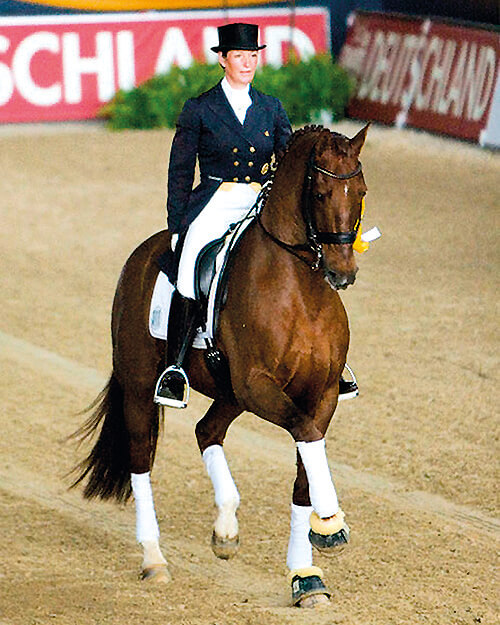
Leonie and Orion at the Europeans
One of the world’s most sought after dressage coaches is about to forsake the officals’ box for a place in the competition arena!
Leonie Brammall last rode an international Grand Prix in 2007, but made her comeback in style, at the 2023 CDI Olomouc in Czechia, riding the homebred Cricket BD, she was fourth in the GP and won the Special!
Born in Canada, Leonie started as an eventer before discovering a passion for dressage and winning a place in the gold and silver medal winning team at the 1981 and 1982, North American Young riders Champs.
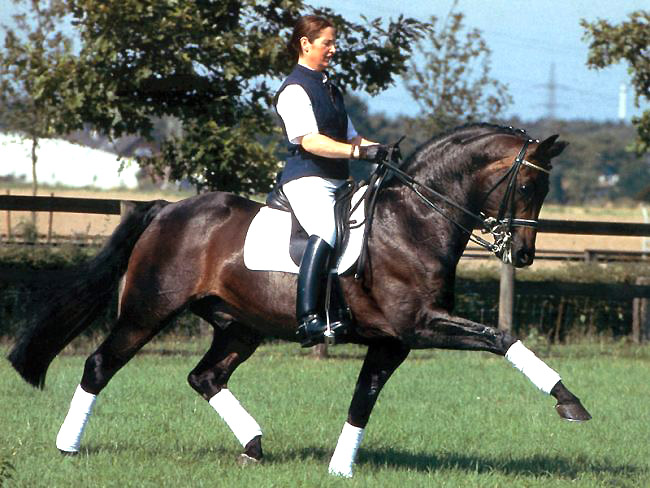
Leonie and the stallion Rohdiamant
Leonie was eighteen when she travelled to Germany to train with Jo Hinnemann, and she has lived in Germany ever since. She weas the head rider at Hinneman’s bard for sixteen years, enjoying success with White Star, Beltain, Relevant, Rhodiament and Don Gregory.
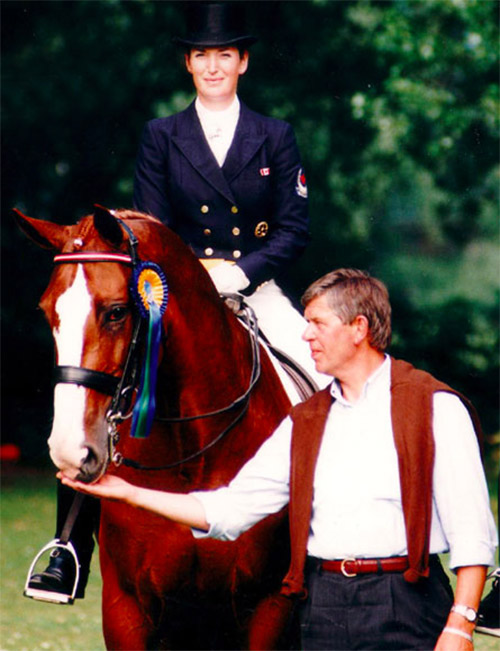 Leonie and Jo and Gilbona, the Oldenburg mare that carried Leonie into the Canadian Team for the Barcelona and Atlanta Games and the WEG in Den Haag.
Leonie and Jo and Gilbona, the Oldenburg mare that carried Leonie into the Canadian Team for the Barcelona and Atlanta Games and the WEG in Den Haag.
She rode the mare Gibona at the 1994 WEG in The Hague and then at the Atlanta Games.
In 2002 Leonie and her partner, Volker Dussche settled in their current home, Gestüt Mühlemort in Isernhagen, where the pair train students and sell horses, that’s when Leonie is not traveling around the world to run clinics. Now 59 years old, Leonie made her comeback on Cricket BD, an eleven year old gelding by Charmeur out of a Don Frederico mare.
Leonie told Eurodressage that a second Olympics with Paris is not out of the question “time will tell if a Paris team spot is a realistic idea or not. Every other horse I have brought up to Grand Prix the last years was always sold. We bred Cricket ourselves and we’re finally in position to be able to keep him and maybe have for me have one last Olympics. I’m not getting any younger. Fortunately in dressage experience is a huge advantage.”
One thing though is certain, Leonie will always be in demand as an instructor, as this report clearly shows…
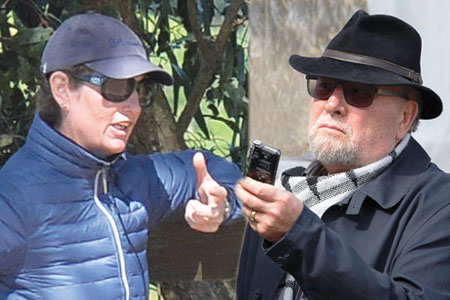
Leonie Bramall is a thinker as well as an insightful and educated rider, it is a powerful combination. Last time she came to Australia, I wrote up her lesson, more or less word for word, as I was so impressed with her subtle, inside-the-mind-of-the-rider teaching style.
This time I thought it would be fun to discuss her training philosophy, her take on the principles of dressage. Still it was impossible not to open by asking about the lesson I’d seen her give with Matt Archibald riding Lucy Liu VDS that was in full swing when we arrived…
When we arrived you were saying to Matt Archibald stretch your right hip…
“He was collapsing – it’s not about getting personal but it is about the balance, some instructors think it is just about getting a product out of the horse, they forget the rider, but it is all connected, if the rider is out of balance the horse is going to be out of balance.”
And why were you getting him to ride with the reins coming into the top of his hand?
“I was asking him to hold the rein through the top part of his hand, (through the top of the hand and out the bottom of the fist) to improve the contact. Using this way of holding the reins to get the feeling – it is a very fine feeling you want – I say to riders, think you are holding two very thin strips of bamboo. When you feel the reins, feel that you are actually encouraging the horse to be pushed out through the nose, and not come back on the bit. I ask the rider to turn the rein around like that, and say, think that you are poking him with a stick. They suddenly realize oh! Then when they are cantering, they get hold of their reins in the normal way and it is like when you row a boat with paddles, when the horse is landing, they are rowing the boat and actually pushing down in the landing moment – NO – row the boat backwards and push up.”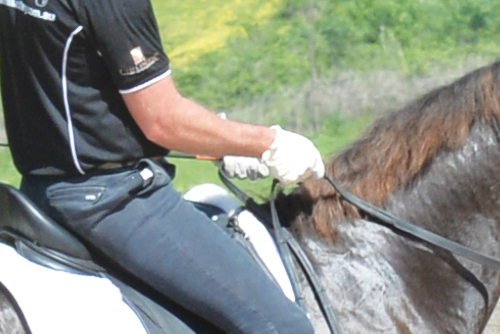
“Putting the reins like that gives riders a different feeling and they can then address the back end. If I get them to do that, I can get them address the back end, work the hind legs through and they can actually then hook it into a contact, so the horse goes over its neck. It was really obvious with that chestnut horse, it was amazing, suddenly the whole neck changed, and they were able to half pass because he had altered the whole front end and the horse was trotting up forward from behind to the bit, which is actually what we are all trying to do.”
more follows
When I started writing about dressage and training clinics, 30 years ago, visiting trainers would come to Australia and say, you must work on your basics… and then the next year another couple would come and they would say, you must work on your basics, and the next year… – let’s talk about these things that we Aussies seem to find it so hard to acquire…
“I think part of the problem is that there is always pressure for the riders to be moving horses along and presenting a picture for the judges that they want to see. I think sometimes riders don’t have enough experience training horses, and they tend to skip a little bit. Not meaning to, just they fail to take care of those details, the rhythm of the horse, pushing at the right moment to make a go moment a positive moment.”
“That for me is an important basic concept, that the horse learns to breathe when the pushing moment comes with the driving aids – so that the horse is in a relaxed positive tension. I don’t mean stress tension but there is a positive type of tension that we all want to see… passaging and piaffing off the ground, that is a positive tension. You create the very positive moment by enhancing what the horse is doing, so when you are pushing in the rhythmical moment then you are enhancing, he is already trotting so you are just enhancing the movement but you have to push at the right moment, and that is what I really try to teach my students.”
Positive tension is a tricky concept, I think Steffen Peters expressed it well when he said, if you ask for expression and lose rhythm, then you have gone the wrong way…
“Exactly. That’s an important point and it also relates to balance. It is not one thing: THE BASICS, it is a combination of balance with the rhythm, with the riders as a possibly interfering part of balance and rhythm. So it is teaching the rider to hook up into those concepts, and keep up with the horse basically.”
Tell me about balance, are we talking self-carriage?
“It’s a relative self-carriage. A very young horse in a longer frame can be in self-carriage, a horse in a piaffe can be in self-carriage, in an extreme amount of collection. It has to do with the balance, and for me, the balance has to do with the quality of the pressure within the horse’s own body, that we influence positively or negatively.”
“Balance is for me is a three dimensional phase that I am trying to push into. So I have longitudinal balance which is from the tail to the ears – which is a young horse, – then I have to start teaching that young horse lateral balance, which is like moving from a leg yield sideways, then I start to combine longitudinal and lateral balance, which is where I get the idea of pushing the horse into the third dimension. I am not just looking at a flat television screen, but I am seeing the horse like a bow that I can push up through the withers, that’s the highest balance point, up through the withers, and then I bend him within that and he stays up in the withers in the bend.”
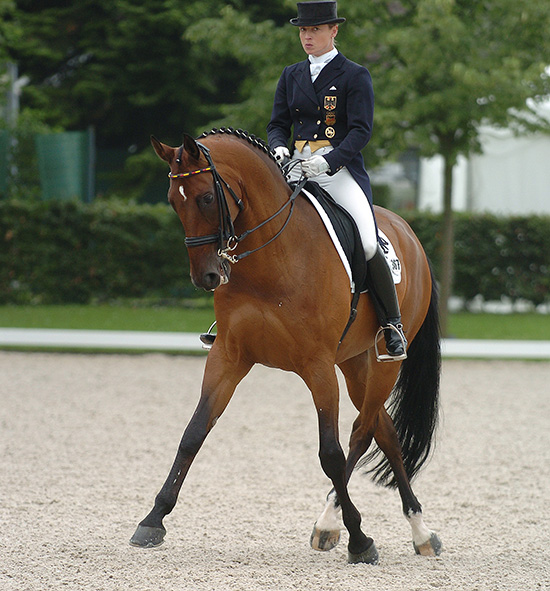
Isabell and Satchmo demonstrates half pass – and Isabell gives Ros ‘the eye’…
“That is for example what happens when Isabell Werth does that amazing half pass with her horses, that we all love, she just lifts up through the withers and the carrying power behind is transferred all the way through and allowed to swing through the front end – that is the epitome of that longitudinal and lateral balance at the same moment.”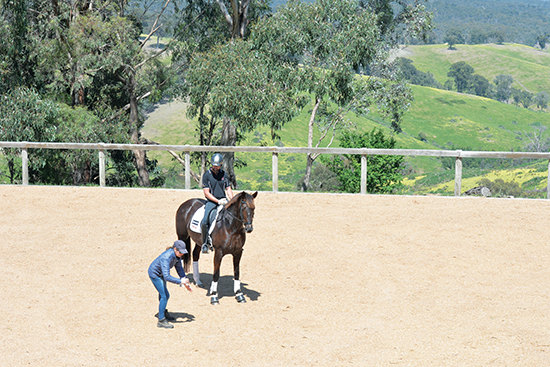
“But it is also important for the horse in the piaffe, even though we are thinking when he is on the spot, there is no lateral balance, however if we don’t have the horse laterally balanced in the piaffe, it will start to weave or twist.”
“That again is a really important issue, it is not about maintaining the straightness, it is about correcting, because a lot of horses when they learn to piaffe there is just a slight weave, and if you don’t take care of that and just ride the piaffe without taking care of that balance problem, they are going to end up stuck with a long/short stride or lifting one hind leg higher… those problems come into place.”
“It is very complex and it all goes back to the basics – walk / trot transition. The balance is also going into the frame and there we are talking about contact and working through the body over the back from the hindlegs into the contact. Those are very important basics that then feed into straightness. It is a hooking up to a system, those basic concepts.”
Contact seems to be one of those ongoing problems that riders have – is it because grabbing at the horse’s mouth with your hand is about the easiest way to get a reaction?
“I think it is the nature of the beast. Humans are front oriented, we are not flight animals, we are actually animals that are active and will kill another animal. So we are front oriented, directly in front of us we can actually manipulate and create a reaction, that’s what we register. So when we are on top of a horse, we pull on the rein, the head goes down, we are happy because we have a result. The horse has given. The problem is that is only 30% of what is happening, 70% is behind.”
“It takes a lot of feeling and experience to understand that often the rider is hindering by getting the horse to give in front because then you have no pressure on the reins which is actually a hopeless concept. The horse has to want to take the contact for me to be able to teach him to engage more behind. He must stay open through the jowl and go forward to the bit. When he is on the bit, he is pushing up through the withers but the jowl flexion point in the throat, stays open, then he has room to move up from the hind leg and actually bend his joints and step up underneath my weight.”
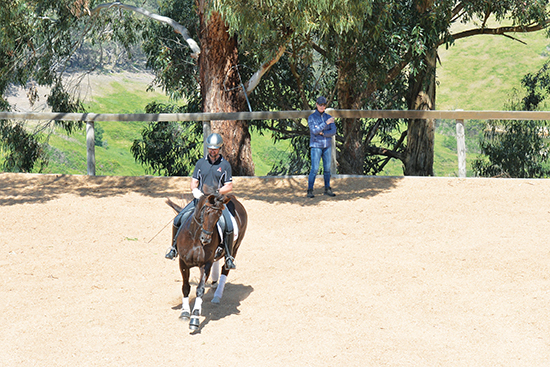 “How successfully the horse can do this depends on his natural ability but it is something we are trying to do with every horse, to have more activity in the hind leg. There is a huge range, some horses have that natural ability to bend and engage, and some have that mental capability to cope with that pressure.”
“How successfully the horse can do this depends on his natural ability but it is something we are trying to do with every horse, to have more activity in the hind leg. There is a huge range, some horses have that natural ability to bend and engage, and some have that mental capability to cope with that pressure.”
“It doesn’t mean pressure as in jamming on pressure, but it means the horse is activated and you are using your aids with exactly the right timing. I try to teach my riders to think, when the horse’s leg is coming off the ground, then access it, then give it a touch with the whip, but it must coincide with the movement of the horse is actually giving you at that moment. Just hitting the horse is pointless, it won’t move off the leg – bash it – that still doesn’t help if you are not trying to find the rhythmical moment to enhance what he is doing, so he understands the concept and becomes reactive and not numb. Often riders push and push and the horse just becomes numb, they actually shut off. They stop reacting because they just get dead.”
Does another tricky basic concept – forward – come in there?
“Forward is an everything. I always say to my riders, think of a horse piaffing, there is a forwards concept in the horse’s body, there is a forwards pressure in the horse’s body, even though the horse has no physical acceleration. It is on the spot, but you are re-cycling energy. You send energy on, and you half halt it, and engage it and you send it on again, and you catch it again. Send it on, and catch it, you have a re-cycling process.”
“Riders try to make activity by going faster. To a certain degree, in an emergency situation where you’ve got a horse that is just stuck, yes that is what you would do. However what we want to do is encourage the horse to engage more, so the frequency within the strides becomes more active, but that the speed that the horse is going does not increase. Same thing when we start to teach the young horse lateral work. He is taught first of all, put the leg on, GO from the leg, we put leg on, he has to go. That is a crucial basic concept. However when we start using lateral aids the horse must also learn that leg on doesn’t just mean go faster, but that he has to wait in the half halts and yield to the leg. That is how we start the lateral work.”
Story continues after the advertisement
Opaque – available to Australian breeders from: https://ihb.com.au/product/opoque/
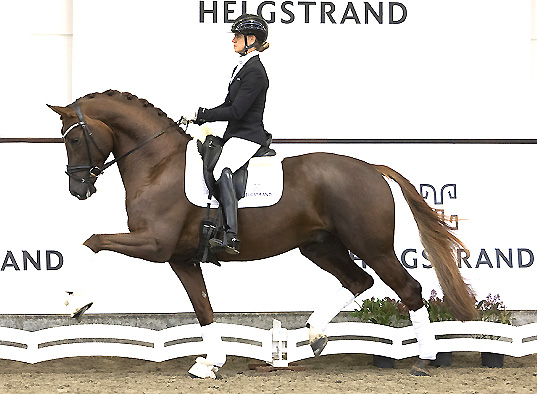
“I always try to teach riders to reduce speed, but don’t reduce activity.”
“Then we get the riders who like to do the swoopy trot, which is one thing that really does my head in. These young horses naturally have a bit of that swingy, passagey trot, and everyone gets excited, look look, he can passage! So we end up with the horse mechanically getting into the swoopy trot, out of balance very often, then they start to do a lateral, diagonal twist, then of course as soon as someone says, okay horse go sideways – the horse backs off, and doesn’t want to go any more. That is a problem that has been created by the rider doing something wrong…”
It’s an evasion when the young horse offers you false passage…
“Of course it is. You get a horse active, and he understands the concept of increasing the dynamics and activity in his movement, then you can start to collect him and using that to lift him off the ground and get more cadence. Cadence is not swoopy, hangy, draggy trotting.”
“Cadence is an enhanced movement where the horse touches to the ground, but you don’t want the energy in his feet to go into the ground, you want him to touch the ground and rebound the energy up again. That it what you are actually trying to create in the passage. A horse that swoops and presses into the ground, and is losing energy into the ground – it is draggy kind of a concept, and that always ends up being a negative. Later it becomes very hard to teach those horses to piaffe because they have never learnt to react to the aid and follow the aid up and forward.”
“When I am teaching a horse with in-hand work, if it doesn’t get off the ground I tap it – I use the moment when the leg has already left the ground, to lead it on forward. It is the same thing under saddle, I want the horse to follow the aid, if I am using my leg aid and it doesn’t respond, I come with my whip, I use it with my leg aid again, and try to get the horse to follow, up and on to the impulsive centre – rather than, you see it all the time, they hit the horse, and it stops, that’s that the wrong way around. They shouldn’t grow roots into the ground when you are trying to get them to go, they should want to lift up, to follow the aids up and forward.”
Where does straight fit into all this?
“It’s really important. For me, there is no dead straight when I am riding. I don’t make a horse dead straight, like a rule would be straight, that doesn’t exist for me – I am always in a slight shoulder fore, it can be a minimal amount, say 2 centimetres – because in that position I have the most access to the horse and I can constantly feed him information, telling him what I’d like him to be doing. Rather that correcting the horse when it is doing quote, unquote ‘wrong’, I’d rather be informing the horse, telling it what I’d like it to be doing, and taking care of him, so that he is comfortable and he knows exactly what is happening all the time – so he doesn’t need to spook, he doesn’t need to run off and do things he shouldn’t be doing.”
“In my straightness, there is always a slight tendency to shoulder fore, it helps me keep that rib cage mobile, so that when I come with my leg I’ve got a spongy, yielding ribcage, rather than I am sitting on a rock or a plank. If the ribs are stuck, the hind legs are never going to come through and come under.”
“Of course straightness is crucial, any horse that deviates out of a crookedness is going to lose pushing power from the back end through towards my feet. Straightness even on a curved line – meaning the horse is tracking up from the back end truly to where the forehand is moving – is an extremely important concept. For me, straightness is the connection from the back end along whatever line you are riding. So if I am going to ride a circle line, and the horse is bent, he is still in a sense, straight, meaning the pressures are directly connected from back to front. He is not straight like a ruler, it is a different way of thinking about straightness, more a connection concept – back to front.”
“You must always make sure when trotting on a circle that the hindlegs are not stepping away. In the canter, when I am trying to do a pirouette, I am still hooking the horse up in a tendency to be straight in a shoulder fore position, but I am thinking more of a little travers behind the saddle. So I am loading the hindquarters and still having that pushing up directly, connected feeling: contact, and balance and hooking up, all those basics to create my pirouette.”
“It doesn’t make sense to work on the things the horse is good at. I always think if a horse can do extended trot, I never do extended trot, if a horse can really collect in passage, I never do it. Why should I use what he is already going to offer me?”
“I need to work on his weaknesses. If the horse can piaffe and passage but he can’t canter very well, then I need to work on my canter to bring my scores up – because working on my piaffe and passage is not going to make my scores come up enough. I can make everything on my score sheet for a 7, then I am going to hit 70%, and if I do that, I am going to be up there. Once I hit 70 and have everything pretty well sorted, then I can start saying if this horse can do that movement so much better, that’s an 8 or an 8.5, so if I can put a basis on my horse by the time he is seven or eight, and I keep working on developing his weaknesses, not pushing his strengths, and working on the weaknesses, often helps everything to come better. As he gets stronger and more balanced, those things are going to help with even the higher movements, and then we can do really well. If I can get everything for a 7, then we can go somewhere.”
“Everyone looks in the book, looks at the videos, and they say, that’s how it should be.”
“But it is not like that all the time, that’s how it looks for the special horses, but it’s not that easy because most of us, especially the professionals, have to deal with very normal horses with problems. And we are the ones that get shat on. People bring us a horse that is totally being a monster and things don’t look good all the time, you give it a smack on its back end, and oooh people don’t like that. But sometimes you have to get something sorted and then go on.”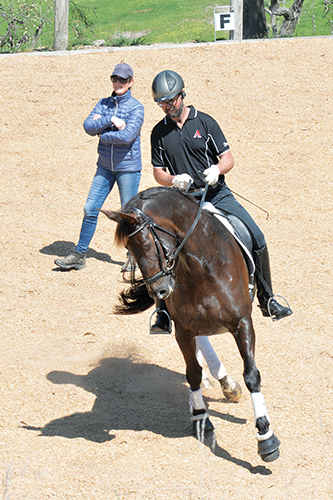
“It is this nagging and hanging, every day negative negative negative, that’s the problem – we’ve got to be careful that everything doesn’t get out of hand, it’s not only about loose reins, that’s not going to work. Horses are never trained by giving them pats and a loose rein.
Sure they need pats, sure they need walk breaks, work a concept then break again and think about it. The riders should incorporate the horse’s weaknesses into their training. They need to understand what the weaknesses are – some people don’t want to know there is a problem with their horse, they just ignore it. If you tell them in a clinic, we need to work on this because that’s where your basic problem is, they just want to go on and do piaffe / passage, that’s fine but they need to go to somebody else.”
“It’s very simple, it is the basic things that have to be established, then you can hook all the rest up. Even position, even taking somebody who is a professional rider – and a lot of times, those guys are the ones that help everybody else but they don’t get help for themselves. You say, hey guy, you really need to make an adjustment because you are stuck here and it is not happening – if they are open minded and take it on board, they can really help themselves and their horses to move on. But we really have to not be precious when someone says you really have to sit up and move your hip over, or your shoulder down, or whatever.”
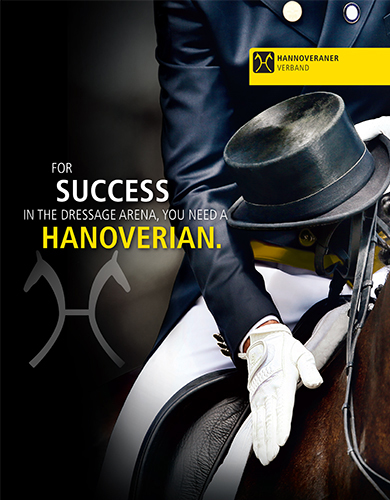
Want more from Leonie – go here:

A very interesting article and on I will be revisiting again and again!
Great article and spot on with her analysis of half halt and definitely a thinking rider